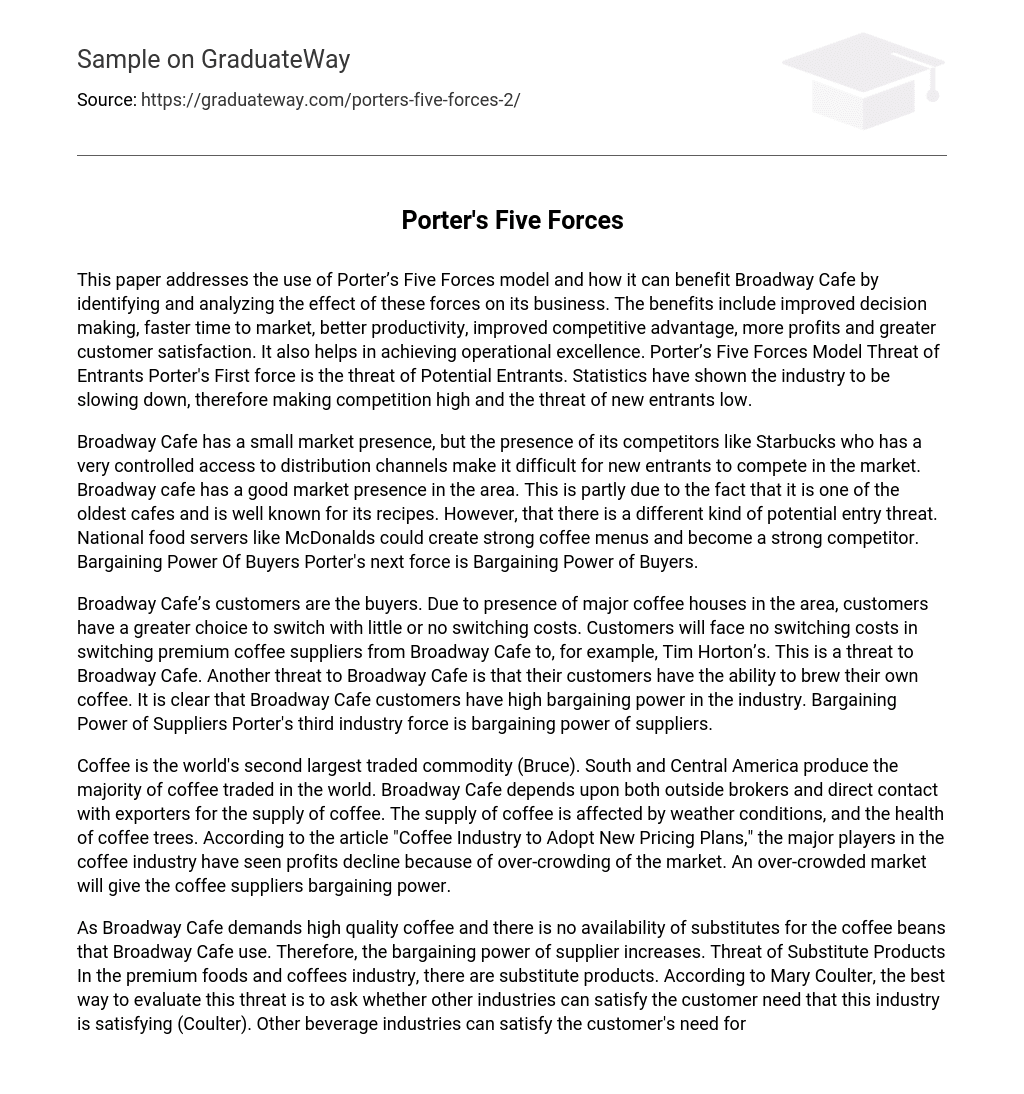This paper addresses the use of Porter’s Five Forces model and how it can benefit Broadway Cafe by identifying and analyzing the effect of these forces on its business. The benefits include improved decision making, faster time to market, better productivity, improved competitive advantage, more profits and greater customer satisfaction. It also helps in achieving operational excellence. Porter’s Five Forces Model Threat of Entrants Porter’s First force is the threat of Potential Entrants. Statistics have shown the industry to be slowing down, therefore making competition high and the threat of new entrants low.
Broadway Cafe has a small market presence, but the presence of its competitors like Starbucks who has a very controlled access to distribution channels make it difficult for new entrants to compete in the market. Broadway cafe has a good market presence in the area. This is partly due to the fact that it is one of the oldest cafes and is well known for its recipes. However, that there is a different kind of potential entry threat. National food servers like McDonalds could create strong coffee menus and become a strong competitor. Bargaining Power Of Buyers Porter’s next force is Bargaining Power of Buyers.
Broadway Cafe’s customers are the buyers. Due to the presence of major coffee houses in the area, customers have a greater choice to switch with little or no switching costs. Customers will face no switching costs in switching premium coffee suppliers from Broadway Cafe to, for example, Tim Horton’s. This is a threat to Broadway Cafe. Another threat to Broadway Cafe is that their customers have the ability to brew their own coffee. It is clear that Broadway Cafe customers have high bargaining power in the industry. Bargaining Power of Suppliers Porter’s third industry force is bargaining power of suppliers.
Coffee is the world’s second largest traded commodity (Bruce). South and Central America produce the majority of coffee traded in the world. Broadway Cafe depends upon both outside brokers and direct contact with exporters for the supply of coffee. The supply of coffee is affected by weather conditions, and the health of coffee trees. According to the article “Coffee Industry to Adopt New Pricing Plans,” the major players in the coffee industry have seen profits decline because of over-crowding of the market. An over-crowded market will give the coffee suppliers bargaining power.
As Broadway Cafe demands high quality coffee and there is no availability of substitutes for the coffee beans that Broadway Cafe use. Therefore, the bargaining power of supplier increases. Threat of Substitute Products In the premium foods and coffee industry, there are substitute products. According to Mary Coulter, the best way to evaluate this threat is to ask whether other industries can satisfy the customer need that this industry is satisfying (Coulter). Other beverage industries can satisfy the customer’s need for a drink, and other food industries can satisfy the customer’s need to eat.
There are obviously good substitutes to Broadway products and the threat is high. This is why it is very important for Broadway Cafe, to innovate and differentiate. By providing free Wi-Fi in the Cafe and marketing signature food products from the famous old recipes of Grandfather, Broadway Cafe can create different image than its competitors. Rivalry Among Existing Competitors Porter’s fifth force that Porter describes is current rivalry among existing firms. In the specialty eateries industry, Broadway Cafe’s current and direct competitors are Starbucks, Tim Horton’s, and Caribou coffee.
Competition, however, is not equally balanced. Starbucks operates in over 20 countries (Starbucks corporate website). Caribou Coffee operates 16 US States and few in other countries (www.caribou.com). Tim Horton’s has a major presence in Canada and USA (Tim Horton’s corporate website). Broadway Cafe is a local cafe. It is clear that Broadway has to compete against these major competitors in the market. It is also evident that Broadway Cafe, given its volume of operations cannot compete with the industry giants directly. A slowing industry market growth is another threat facing Broadway Cafe.
According to the market research firm Allegra, market was estimated to grow at a much slower pace than it did in last ten years. Competitors are selling similar products, including specialty coffees as well as high quality foods. In this slowing market, competition is very high. Summary By evaluating the Porter’s five forces model, it can be summarized that Broadway Cafe is in a very tough environment. Though the risk of new entrants is low, but the threat from existing competitors is very high. Broadway Cafe needs to be very focused on the customer relations and the quality of their products.
Broadway Cafe can try to offset the higher bargaining power of buyers by implementing loyalty program. Given the scale of business and the strong influence of competitors over the suppliers, it is difficult for the Broadway Cafe to have a strong control over its suppliers. Since Broadway Cafe is in a food and drink industry, and in this industry, there are many good substitute products. The threat of substitute products is high. Broadway can minimize this threat by effectively marketing their signature recipes to the customers.





